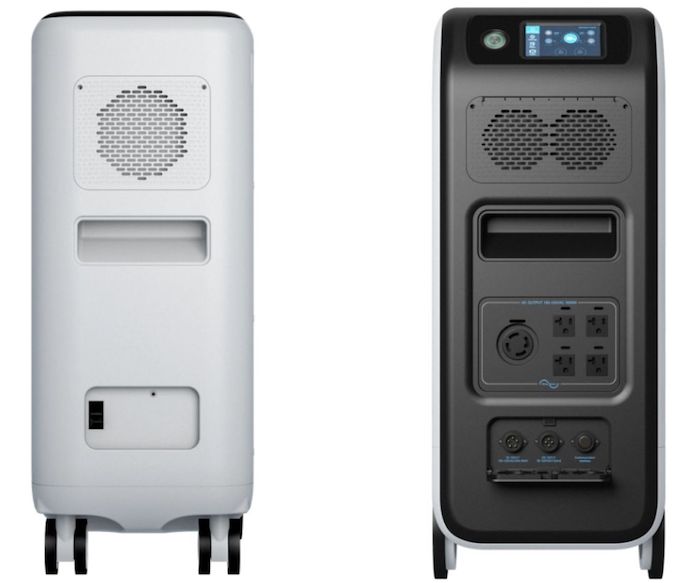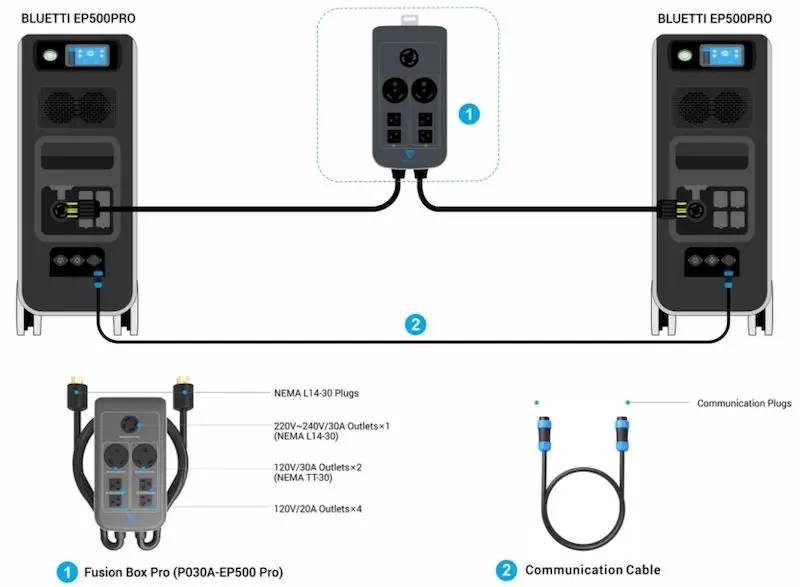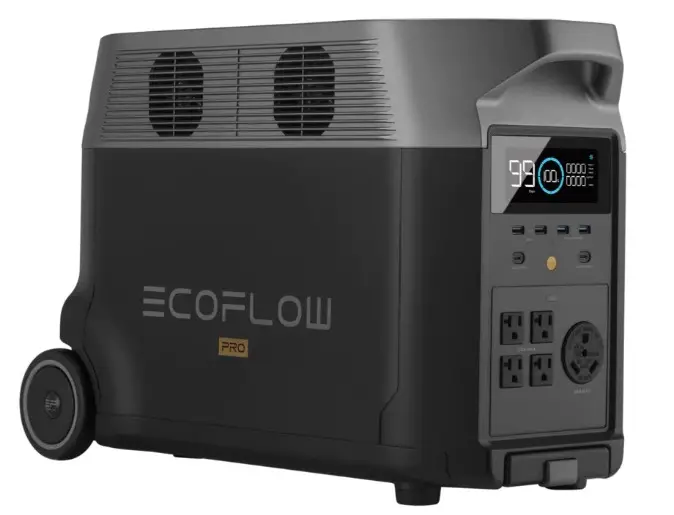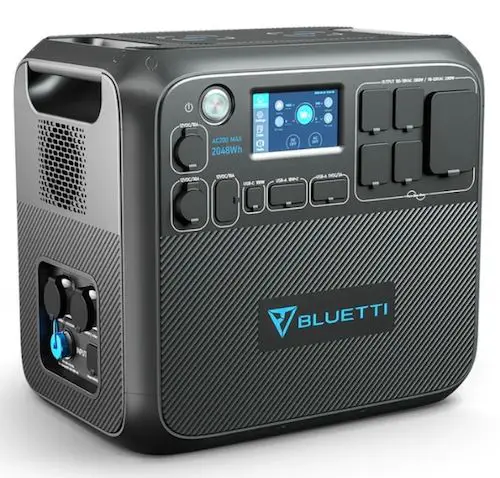I’ve done research on solar generators that work best for various off-grid activities/scenarios, and I thought I’d compile my findings to give you my top picks.
The best solar generator for off-grid living is the Bluetti EP500Pro. Its 5,100Wh LiFePO4 battery has the longest cycle life of any portable power station (6,000+ cycles to 80% capacity) and it has the highest solar input currently available (2,400W max).
The EP500 also competes for the largest battery in a single solar generator (5,100Wh) which loses only to the Yeti 6000X (6,071Wh).
However, the EP500Pro may not be the best option for all off-grid living styles.
The following table compiles my research into the best solar generators for multiple off-grid formats.
| Ranking | Model | Highlights |
|---|---|---|
| 1. Best Overall | Bluetti EP500Pro | – Large & long-lasting LiFePO4 battery – High solar input & AC output – Can combine two units for 2x output power |
| 2. Best in Versatility | EcoFlow Delta Pro | – EcoFlow’s X-Boost (high AC output) – Long-lasting LiFePO4 battery – Can expand battery capacity up to 25kWh |
| 3. Best Compact Option | Bluetti AC200MAX | – Large but compact LiFePO4 battery – Can expand battery up to 8.2kWh – 16 total outputs |
Let’s dive into each of these power stations in more detail.
1. Bluetti EP500Pro
The EP500Pro is the advanced version of the standard EP500. What sets this solar generator apart from the others is its massive and long-lasting battery.
Besides its battery, this power station has a high-powered inverter, charge controller, along with several advanced features that make it ideal for off-grid use.
| Category Analyzed | Max’s Score | Comments |
|---|---|---|
| Standard Battery | 10/10 | Massive 5,100Wh capacity and uses a long-lasting LiFePO4 battery (rated for 6,000+ cycles to 80%) |
| Battery Expansion | 7.5/10 | Can only connect two EP500Pros together (10.2kWh) |
| Ports (Inputs & Outputs) | 9/10 | Has a powerful solar input port along with 16 total outputs |
| Recharging Time (Solar) | 10/10 | Charges from 0-100% battery in 2.6-3.1 hrs at its max input of 2,400W |
| Unique Features | 10/10 | Mobile app, UPS, split phase, peak load shifting |
| Price | 10/10 | $5,499 (high upfront cost but it’s the longest-lasting portable power station on the market) |
| Overall | 56.5/60 | The EP500Pro has the culmination of advanced technology, high input/output power, and battery longevity – all of which are ideal for long-term off-grid power |
EP500Pro – specifications & features
Battery details
- Battery capacity: 5,100Wh
- Cell type: LiFePO4
- Lifecycles: 6,000+ to 80% capacity
- Battery expansion: No external batteries available, but can connect to a second EP500Pro for double the battery capacity
Output ports
- 2x wireless charging pads (15W each)
- 4x USB-A ports (2x standard; 2x fast charge)
- 2x USB-C ports (100W)
- 4x 100-120V AC ports (3,000W continuous, 6,000W surge)
- 1x 12V car port output
- 2x 12V/ 10A DC ports
- 1x 12V/ 30A RV port
Input ports
- 1x AC input
- 1x Solar input and T500 input
- 1x communication interface (connects two EP500s)
Unique features
- Smartphone application
- Wheels
- Touchscreen
- UPS function
- Split phase bonding
- Peak load shifting
Other
- Weight: 182 lbs
- Dimensions: 22.8 x 11.8 x 29.9 in
In its large yet versatile frame lies capabilities ideal for not only home backup power, but power for off-grid cabins, RVs, and even boats.
Bluetti EP500Pro vs. EcoFlow Delta Pro
Although the EP500Pro cannot compete with the Delta Pro’s battery expansion capabilities, it does dominate its solar input max.
The EP500Pro leads the power station industry with a 2,400W solar input max (1,600W for the Delta Pro).
Both the Delta Pro and EP500Pro can utilize 240V power for home appliances. To achieve this, you need two power stations as well as a connection piece that has the needed 240V output(s). The diagram below shows how to connect two EP500Pros to the Bluetti Fusion Box for 240V power.
In addition, the battery lifecycles of the EP500Pro far exceed the Delta Pro.
- EP500Pro: 6,000+ cycles to 80% battery capacity
- Delta Pro: 3,500 cycles to 80% battery capacity
Not only will the EP500Pro have nearly double the lifetime of the Delta Pro, but the EP500 has 1,500 additional watt-hours in its standard battery. It’s one of the biggest solar generators in terms of single battery size, plus, it’s the longest-lasting solar generator that I know of.
EP500Pro – pros & cons
| Pros | Cons |
|---|---|
| Longest-lasting battery (6,000+ cycles to 80%) | Heavy (182 lbs) |
| Highest solar input (2,400W max) | No battery expansion available (besides connecting two EP500s together) |
| Advanced tech (mobile app, UPS, split-phase bonding, etc.) | No 120V/30A RV output |
Overall, the EP500Pro’s versatility, longevity, and power make it the best solar generator for off-grid living.
I have more information on the EP500 and EP500Pro in my review article, where I dive deeper into their unique features and compare them to similar solar generator models.
You can find the review article here: Bluetti EP500 & EP500Pro Review – Longest-Lasting Solar Generators.
I also have two YouTube videos on the EP500 and EP500Pro, and you can check them out below.
As for buying options, the EP500Pro is available on Bluetti’s website below.
2. EcoFlow Delta Pro
The Delta Pro is EcoFlow’s first portable power station with a lithium-iron-phosphate battery.
With a long-lasting battery setting the foundation for the Delta Pro, its input and output power combined with its unique and user-friendly features make it one of the most versatile large solar generators you can buy.
You can monitor it with the EcoFlow app and recharge it from an EV charger (unique to the Delta Pro).
The EcoFlow Delta Pro has a wide range of capabilities including an AC inverter rated at 3,600W continuous (7,200W surge) and optional battery expansion (up to 25kWh). It can also run 240V appliances by pairing two Delta Pros together via EcoFlow’s Double Voltage Hub.
One of its many strong suits is its ability to connect up to two external batteries to its mainframe (10.8kWh total). If you want even more power, you can connect multiple Delta Pros together to have an off-grid system with up to 25kWh of battery storage.
| Category Analyzed | Max’s Score | Comments |
|---|---|---|
| Standard Battery | 9/10 | Has a 3,600Wh LiFePO4 battery rated at 3,500 cycles to 80% capacity |
| Battery Expansion | 9.5/10 | Doubles its capacity with each additional 3.6kWh external battery (2x batteries per power module); can pair multiple batteries and modules for up to 25kWh of capacity |
| Ports (Inputs & Outputs) | 10/10 | Has 15 total outputs, including the most powerful AC ports; also has an EV charging port that can take in up to 3,400W of input |
| Recharging Time (Solar) | 9/10 | Recharges in 2.8-3.2 hrs with its 1,600W max solar input |
| Unique Features | 10/10 | Mobile app, UPS, split phase, can charge with EV charger |
| Price/Value | 8.5/10 | $3,599-3,699 (has powerful ports and unique features, but has 800W less solar input capability and half the battery cycle life versus the EP500Pro) |
| Overall | 56/60 | Being high-tech, powerful, and expandable, the Delta Pro can be utilized in several different off-grid living situations |
Delta Pro – specifications & features
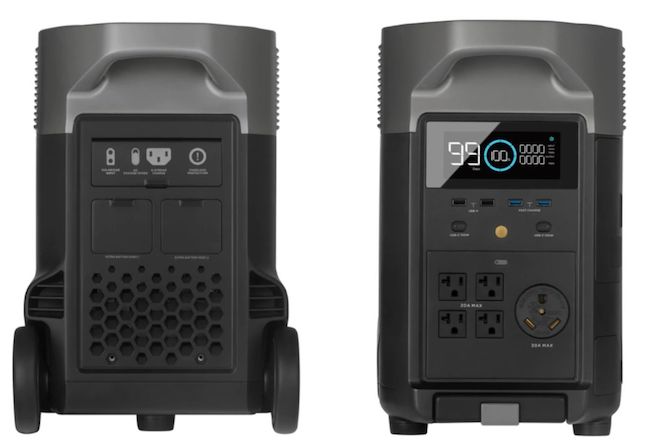
Battery details
- Battery capacity: 3,600Wh
- Cell type: LiFePO4
- Lifecycles: 3,500 to 80% capacity
- Battery expansion: Yes (3.6kWh external battery; up to two batteries per power module; can combine multiple batteries and modules for 25kWh total)
Output ports
- 4x USB-A ports (2x standard; 2x fast charge)
- 2x USB-C ports (100W)
- 5x 100-120V AC ports (3,600W (4,500W w/ X-Boost) continuous, 7,200W surge); one AC port is a 30A port
- 1x Car port output (12.6V/ 10A)
- 1x 12V/ 30A Anderson port
- 2x DC5521 ports (12.6V/ 3A)
- 1x 12.6V/ 30A RV port
Input ports
- 1x AC input
- 1x Solar/car input (XT60)
- 1x EV charging input (also used to connect two Delta Pros together)
Unique features
- Smartphone application
- Wheels + telescoping handle
- UPS function
- Split phase bonding
- Can charge from EV charger & wind turbines
Other
- Weight: 99 lbs
- Dimensions: 25 x 11.2 x 16.4 in
Delta Pro – pros & cons
| Pros | Cons |
|---|---|
| Highest AC power output available | Expansion batteries don’t stack on top of one another |
| Multiple unique features (mobile app, UPS, split-phase bonding, etc.) | 1,600W solar input is good, but adding more batteries will significantly increase recharging times |
| Can be recharged from an EV charger | Heavy (99 lbs) |
One word to describe the Delta Pro is versatile. It supplies as much power as you need for several devices and appliances.
Not only that, but its efficient LiFePO4 battery will provide a long usable lifetime off the grid.
Depending on what you need, you can create a solar generator setup that is simple or add batteries and modules to support multiple high-powered appliances.
Being integrated with the EcoFlow app, the Delta Pro can be managed from your phone. The app lets you adjust several features to customize your system to your liking.
I’ve used the EcoFlow app for my River 600 Max and it really enhances how I can use it. If you want more details on the app you can read my review of my River 600 Max here: EcoFlow River 600 Review – Testing My River Max + Comparisons.
3. Bluetti AC200MAX
The AC200MAX is nearly 40 pounds lighter than the Delta Pro and exactly 120 pounds lighter than the EP500Pro. At its longest measurement, this power station is nearly 10 inches shorter than the EcoFlow Delta Pro’s equivalent.
With its lighter weight, the AC200MAX is easier to maneuver than the Delta Pro and EP500Pro (although it doesn’t have wheels). Similarly, its smaller dimensions make it more reasonable to work with when limited space is available.
If more battery capacity is needed, you can connect up to two of Bluetti’s B230 or B300 expansion batteries. With two B300 batteries attached, the AC200MAX has 8.2kWh of available battery capacity.
| Category Analyzed | Max’s Score | Comments |
|---|---|---|
| Standard Battery | 8.5/10 | Carries a 2,048Wh LiFePO4 battery with 3,500+ cycles to 80% capacity |
| Battery Expansion | 8/10 | Can connect up to two 2.3kWh or 3kWh external batteries (8.2kWh max); connects to 3rd party batteries as well |
| Ports (Inputs & Outputs) | 10/10 | Has a 12V/30A Super DC output port, a powerful 30A RV port (2,200W continuous), and 16 total output options |
| Recharging Time (Solar) | 8/10 | Takes 2.8-3.3 hrs to fully recharge at 900W of max input |
| Unique Features | 9/10 | Mobile app, diverse DC ports, touchscreen |
| Price/Value | 8/10 | At $1,899, the AC200MAX is relatively inexpensive compared to similar-sized power stations |
| Overall | 51.5/60 | With several port options, a LiFePO4 battery, and high-tech internals, this model is essentially a smaller version of the EcoFlow Delta Pro |
AC200MAX – specifications & features
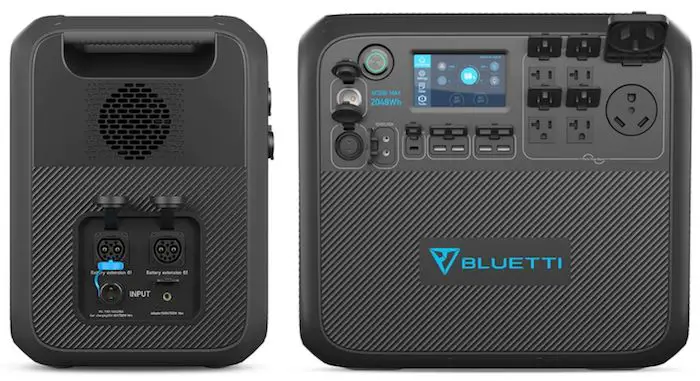
This power station offers the same touchscreen and Bluetti application for mobile use as the EP500Pro.
The AC200MAX also has two 30A output ports, including a 120V RV port and a 12V “Super DC” port.
A unique feature that often gets overlooked is its port covers. All of the AC200MAX’s input and output ports have covers.
These covers protect the system from getting water/dust damage and are surprisingly rare to find in most solar generators.
Battery details
- Battery capacity: 2,048Wh
- Cell type: LiFePO4
- Lifecycles: 3,500+ to 80% capacity
- Battery expansion: Yes (can connect up to two 2.3 and/or 3kWh external batteries)
Output ports
- 2x Wireless charging pads (15W)
- 4x USB-A ports (2x standard and 2x fast charge)
- 1x USB-C port (100W)
- 4x 100-120V AC ports (2,200W continuous, 4,800W surge)
- 1x 12V/ 30A Super DC port
- 1x 12V/ 10A car port output
- 2x 12V/ 10A DC5521 ports
- 1x 120V/ 30A RV port (NEMA TT-30); 2,200W continuous, 4,800W surge
Input ports
- 1x AC input
- 1x Solar/car input (T500); also used for external lead-acid batteries
- 2x External battery inputs (for Bluetti B230 or B300)
Unique features
- Smartphone app
- Touchscreen
- Can connect 3rd party batteries
- Wireless charging ports
- Super DC port (12V/30A)
Other
- Weight: 62 lbs
- Dimensions: 16.5 x 15.2 x 11 in
AC200MAX vs. AC200P
The AC200MAX is an updated version of the AC200P. There are several upgrades to the AC200MAX versus the AC200P, a few of which are:
- Improved continuous AC power output (2,200W vs. 2,000W)
- 120V/30A RV port (not in the AC200P)
- Improved solar input (900W vs. 700W)
- Ability to pair with the Bluetti app
The AC200P is an excellent power station regardless of its successor’s improved capabilities. If interested, you can check out the AC200P on Amazon here (affiliate link). It will cost you about $400 less than the MAX version.
More information on the AC200P can be found in my comparison article, where I compare it to the first generation AC200 solar generator. You can read it here: Bluetti AC200 vs AC200P – Key Differences & Takeaways.
AC200MAX – pros & cons
| Pros | Cons |
|---|---|
| Diverse output options (16 total) | Doesn’t have wheels (weighs 62 lbs) |
| Battery expansion available (up to 8.2kWh) | You may need expansion batteries if you intend to run high-powered appliances for long durations |
The AC200MAX provides a high amount of power with a mobile application, battery expansion, and versatile port options.
If you don’t need a ton of power (like the Delta Pro and EP500Pro deliver) from AC ports and could use a system with a smaller footprint, this is the best option available.
Average power consumption for off-grid living situations

An off-grid cabin’s energy consumption varies greatly, but a large cabin with energy-efficient and/or downsized appliances (compared to a typical home) will use about 22.5kWh per day. This is 75% of the average 30kWh per day used by a regular home.
Considering that the average off-grid home needs about 7,000W (7kW) of solar panels to run entirely off the grid, this equates to daily solar energy production between 17.5 and 28kWh (50-80% solar panel efficiency).
The number of solar panels needed can be offset by using propane tanks, gas generators, or wind turbines to power various appliances.
To find the best generator for an off-grid cabin, I’ve compiled my top picks in my roundup post here: 5 Best Solar Generators for Cabins (Plus Example Scenario).
A camper van’s energy consumption will fall between 2.5-4.5kWh used daily. This depends on the various appliances in the van as well as their energy efficiency. The air conditioner tends to consume the most power compared to other appliances in the vehicle.
The average RV or travel trailer uses about 20kWh of power every day when in use.
- RV/Travel Trailer: 20kWh/day (source)
- Off-Grid Cabin: 22.5kWh/day – I took 75% of the average home power consumption of 30kWh (source)
- Camper Van: 3.5kWh (source)
Since the amount of power used varies greatly depending on your own off-grid living situation, I highly recommend that you calculate your average consumption using a simple calculator tool.
This will align you to exactly which system will work best for your needs.
Daily electricity usage offset using solar generators

Based on the averages above, I compiled a table illustrating the percentage of power that each solar generator can deliver in a single day.
I included the standard/baseline battery capacity of each unit along with its maximum available battery capacity from utilizing additional external batteries.
| Power Station | Battery Capacity Range* | Off-Grid Cabin | RV/Travel Trailer | Camper Van |
|---|---|---|---|---|
| Bluetti EP500Pro | 5.1-10.2kWh | 22.7-45.3% | 25.5-51% | 100% |
| EcoFlow Delta Pro | 3.6-25kWh | 16-100% | 18-100% | 100% |
| Bluetti AC200MAX | 2.05-8.2kWh | 9.1-36.4% | 10.3-41% | 58.6-100% |
There are a few things I want to discuss regarding the above numbers because (obviously) not all cabins, RVs, and camper vans are the same:
- In order for all appliances to run successfully with your system, you may need more than one main power module
- The amount of extra batteries and power modules needed depends on how often you intend to use RV/cabin/van
- Please note that the summer months will most likely have higher energy use
- The cost of creating the largest possible solar generator system will be significant
As mentioned prior, the practicality of using a solar generator system for living completely off-grid depends on your financial and power requirements.
One of my honorable mentions that didn’t make this list is the Titan solar generator. I recommend checking out this system because of its power output and massive 2,000W solar input. You can find my review of it here: Titan Solar Generator Review – The Best Large Solar Generator?


